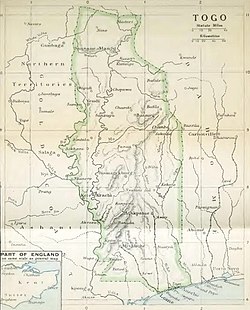| Affair of Agbeluvoe | |||||||
|---|---|---|---|---|---|---|---|
| Part of the Togoland Campaign of the First World War | |||||||
 Map of Togoland | |||||||
| |||||||
| Belligerents | |||||||
| Commanders and leaders | |||||||
|
H. B. Potter H. S. Collins |
| ||||||
| Strength | |||||||
| 2,642 | 1,500 | ||||||
| Casualties and losses | |||||||
| 83 | 41 | ||||||
| Numbers and casualties relate to personnel in the colonial forces regardless of origin. | |||||||
Map of Togo | |||||||
The Affair of Agbeluvoe ["affair" a military engagement by a force less than a division] (Agbéluvhoé, Beleaguer or the Battle of Tsewie, was fought during the First World War between invading British Empire soldiers of the West African Rifles and German Polizeitruppen (paramilitary police) in German Togoland (now Togo) on 15 August 1914.[a] British troops occupying the Togolese capital of Lomé on the coast, had advanced towards a wireless station at Kamina, 100 mi (160 km) inland on hills near Atakpamé. The only routes inland were by the railway and road, which had been built through dense and almost impassable jungle.
Two trainloads of German troops steamed south to engage the British and delay the Anglo-French invasion but were ambushed at Agbulovhoe, suffered many casualties and fled, leaving 30 mi (48 km) of the railway to the north intact. After a halt of three days to accumulate supplies, the British advance resumed with support from French Tirailleurs Sénégalais. The German colonial forces were capable of only one more defensive action at the Affair of Khra on 22 August. The Germans blew up the wireless transmitter at Kamina on the night of 24/25 August and the colony was surrendered the next day.
Cite error: There are <ref group=lower-alpha> tags or {{efn}} templates on this page, but the references will not show without a {{reflist|group=lower-alpha}} template or {{notelist}} template (see the help page).

